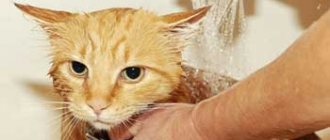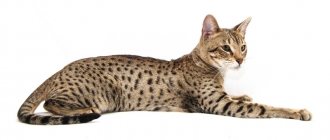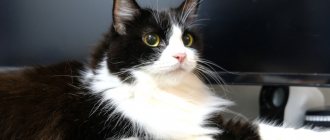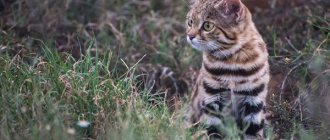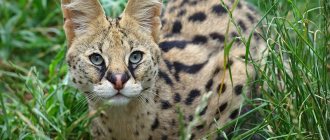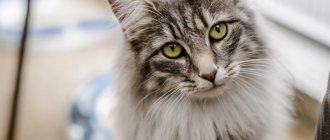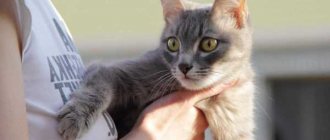The Somali cat is an amazingly beautiful creature. In 1967, Evilyn Megue, an American breeder of Abyssinian cats, took into her home a cat that had already been abandoned by about five owners within a short time. The incredible beauty of the resulting Somali breed shocked Evilin. She decided at all costs to find out at least something about his origin.
Description of the Somali breed and its character
The first Somali cat was bred back in the 40s of the last century, but she could not win appreciation in society. Only in the 60s did this breed gain great popularity, which happened thanks to the famous breeder E. Maggue, who saw unprecedented elegance and impeccable appearance in the fluffy beauty.
The owner began to present her Somali pet at exhibitions, where she was officially recognized. Soon there was a great demand for this breed. Today, Somali cats are popular and in demand in different countries of the world, but in Russia this breed is still only living and is considered rare.
| Average weight | 3-5 kg |
| Size, height | Small cats, adult height 25-30 cm |
| Body | Graceful, with graceful curves, but at the same time quite strong and muscular with a convex chest and smooth outlines |
| Paws | Slender, graceful, the ends of the paws are rounded, with noticeable tufts of hair between the pads |
| Head | Large, wedge-shaped, with a small chin and large ears, pointed at the tips. |
| Eyes | Expressive, almond-shaped with clear contours |
| Tail | Fluffy, resembles a fox, quite large |
| Wool | Thick, soft, medium length, ticked shade |
Somalia is an amazing cat with a great character! She is inquisitive and playful, easy to train and obedient. The playful temperament of Somali kittens lasts for many years; even older representatives of the breed enjoy spending their free time in active games.
Such a representative is the soul of any company; she loves attention, but is not intrusive. The purebred cat is friendly and not aggressive, easily communicates with other pets and quickly takes root in a home where there are small children.
They will be glad to have their own toys, and in their absence, they will independently find an exciting object for entertainment.
Somali cats are very sensitive and observant. They feel the mood of people and will never impose their company at the wrong time. They can be left alone with children without fear; even during an exciting game, the smart animal will not offend the child or release its sharp claws.
Little Somalis love to misbehave, but if the owner pays attention to raising the pet, any problem can be quickly solved, due to the cat’s incredible obedience and decent understanding of commands from the beloved owner. They are easy to train and train!
This breed has other positive qualities. For example, a Somali cat loves freedom and can always stand up for itself, showing courage and self-confidence in any conflict situation with street animals.
Description
Somalia is an aristocratic cat, distinguished by a graceful, fit body, long thin paws and incredibly intelligent eyes.
Head and muzzle
The Somali head has the following features:
- Wide skull.
- Rounded muzzle.
- Slight narrowing in the area of the vibrissae.
- Slight curve from forehead to nose.
- Cup-shaped large ears.
- Almond-shaped eyes of golden or emerald shades.
Frame
The small, flexible and graceful body of cats has such features as:
- Wide chest.
- Slight arch of the back.
- Limbs elongated in proportion to the body.
- Wide “fox” tail, thickened at the root.
Specific character traits
Breeders often highlight the Somali as the "ideal breed" for:
- Silence.
- Energy.
- Curiosity.
- Artistry and desire to be the center of attention.
- Obedience, predisposition to training.
- Communication skills, including with other animals.
- Understanding of children, lack of cruelty.
- Mischief, need for toys.
Coat and colors
Pastel colors, plain clean undercoat. The presence of ticking is required - a kind of coloring characterized by alternating hair pigments from the dark bottom to the lighter end. The fine, soft hair is elongated on the neck and hind legs.
Required marks
Despite the differences in color, all Somalis must have:
- “Shadow” stripe along the spine;
- Darker cheekbones and vibrissae area;
- “Glasses”: light fur around the eyes;
- Vertical shadow-like stripes from eyes to ears.
“Wild” and “sorrel” are considered canonical, the rest appeared later.
Wild
Brownish-orange coat with dark tips. The chest and inside of the paws are painted a soft apricot color. White inclusions are not acceptable.
The ears and tail are dark, and the same fur is present between the toes. Carmine nose with black trim. The pads are jet black.
Sorrel
The shade varies from dark copper to soft beige. The ears and tail are dark brown, as are the soles of the paws. The fur between the paws matches the shade of the body. The nose is soft pink.
Blue
Light smoky coat with a cream base. Alternating blue stripes on the body. Light charcoal pads, dark pink nose with black trim.
Faun
Light uniform apricot shade, creamy pink pads and nose.
Silver
It is rare and has a distinctive feature – a snow-white undercoat, which is why it is not recognized by all associations.
Colors of cats and kittens of the Somali breed with photographs
The most common coat color for this breed is a wild, red with black tips, a light apricot tint on the inside of the body, and a dark tint on the back.
Also popular is a copper-red shade (sorel) with dark red shading.
An amazing coat of smoky blue and silver with a white undercoat and a variety of shades!
How much does the Somali breed cost in Russian regions?
Prices for Somali cats vary, depending on many criteria. Purebred kittens with good pedigree and good health are sold at higher rates.
So, for example, in Moscow and St. Petersburg you can pay about 40-50 thousand rubles for such a noble representative. Such kittens are often purchased for participation in exhibitions and breeding.
You can buy a Somali cat in St. Petersburg, Krasnodar, Ufa or Chelyabinsk for 5-10 thousand rubles. As a rule, such animals are sold by private traders who are not particularly eager to obtain high-quality offspring. Their interest is in quantity; the larger the offspring, the higher the profit. They rarely pay attention to quality veterinary care for kittens, save on care products, etc.
When purchasing such a kitten, there is no guarantee that it is purebred or in excellent health. You can get such pets only for yourself, without plans to breed offspring and participate in various events where the best representatives of different breeds gather.
On average, the price for a Somali kitten in different regions of the country is 20-40 thousand rubles.
If you decide to buy a purebred representative with documents and excellent health, do not look for cheap options, buy a Somali from a reputable nursery, where they will guarantee its origin and the high quality of the breed.
Purchase rules
The average price tag for pet-class Somalia ranges from ten to fifteen thousand rubles, show class costs much more. The price depends on gender, external characteristics, color and the presence of pedigree.
It is recommended to purchase purebred pets from specialized nurseries or professional breeders.
A healthy cat does not appear too fearful or aggressive. The coat should not have a gray or sandy tint, and there should be no white spots.
The future breeder should pay attention to the number of fingers, teeth and ears. Pedigree checking for hereditary diseases is mandatory.
1111
Somali catteries
Despite the fact that the Somali cat breed is not very common in Russia, there are specialized nurseries in different regions of the country that are ready to provide purebred Somali kittens for show, breeding and pet classes.
There are several such nurseries in Moscow:
- Somarineko;
- "Skiman";
- Tiger Fun;
- wildfox;
- Garfield.
In St. Petersburg - SILK TASSEL, Incendie Etoile and Cat Manor. You can buy a purebred Somali cat in the LUCKY COMPANY nursery in Krasnodar, “Zulu” in Tomsk, Amber rain in Ryazan, TaVi Style in Orenburg, “Zula Cat” in Volgodonsk.
Nutrition
The cat tolerates high-quality ready-made food or food prepared at home equally well.
It is important not to alternate them with each other and to feed only something specific. The diet must include meat, eggs, dairy products, and butter.
Who to choose: a male cat or a Somali cat?
Little Somali kittens are very touching and funny. When choosing a pet for your home, you need to decide on the gender of the animal - boy or girl? In order not to make a mistake in this decision, you need to study the individual characteristics of cats and kittens.
Cats are more affectionate and attached to their owner. They get used to their new home faster and behave more carefully and cautiously. General characteristics also include observation and curiosity of the fair sex.
The owner of a cat of the Somali breed must understand that his pet may soon bear offspring.
If you are not going to engage in breeding of Somalis and want to eliminate problems with the appearance of kittens, it is better to agree in advance with a veterinarian and carry out the age-appropriate sterilization procedure.
Experts strongly do not recommend keeping a cat at home during the period of heat, trying to exclude sexual contact with street representatives. Abstinence from the natural process can negatively affect the psychological and physical condition of your pet.
In addition, a cat that wants to go on a spree will simply not give rest to all household members; it will hysterically look for a way out of the room and demand access to the street.
Males are less problematic in terms of offspring. You can let him go outside without fear, without worrying about the offspring. But you should understand that a wandering cat may not return home for weeks, and in some cases, after such sprees, they disappear forever.
In order not to lose your pet, you can perform castration, which is important if the cat has free access to the street.
There is also the option of finding a purebred cat for mating, which will save you from worries and other possible problems, and at the same time calm down the unbridled sexual fervor of your furry friend.
Temperament and habits
The character of the Somali cat is quite complex. Moreover, both kittens and adult pets are very playful and active. But the Somali owner need not worry about his favorite vase or the integrity of the furniture.
Somali cats are quite obedient and intelligent. In addition, they are able to make friends with other animals, even hamsters, and children. True, it is worth explaining to young household members that it is impossible to torture a cat, that it is a living creature like themselves.
- Somali women love affection and attention, but in moderation. Sometimes they want to go for a walk on their own. Of course, not around the yard, but to be alone with yourself, stretched out on a couch or curled up in a cozy chair.
- The voice of the Somali cat is very soft, gentle, pleasant. They purr loudly. Their habits are quite tactful and unobtrusive.
- A Somali cat will not hurt or scratch a small child. In the game, the pet is quite intelligent and tactful. A Somali woman is a great friend and companion. It's a pleasure to look after her.
- They are not arrogant and submissive. By the way, pets of this breed can even learn a couple of commands. They understand the words well: “you can’t”, “let’s go eat”, “go and pet me.”
In general, you can teach your pet to sit on your lap or “ask” it not to visit the dinner table or crib.
However, it should be remembered that these are still cats, not dogs. If the family has to move, the Somali woman will tolerate it well and quickly get used to the new conditions.
Preparing Somalia for the exhibition
Graceful cats of the Somali breed with an unusual appearance are ideal for participation in exhibitions, especially since there are not so many such representatives in our country. If you plan to attend such events with your pet, organize proper care from an early age.
What criteria must a purebred cat meet to participate in exhibitions:
- Decent physical shape. Good health, to maintain which it is necessary to create a proper diet based on balanced food.
- The cat must be self-possessed, obedient and well-mannered, which will allow the participant to demonstrate only the positive side.
- The animal must not have any defects leading to disqualification.
- Ideal appearance, well-groomed and clean coat, proper grooming, enhancing the natural beauty of this breed.
You need to begin active preparation for the exhibition 3-4 weeks before the planned event. If your cat is overweight, it’s time to take action and switch it to feeding it special foods that do not cause additional weight gain.
You can add vitamin supplements and healthy foods to your diet that are recommended by veterinarians on an individual basis. So, for example, seaweed will make the shade of the coat brighter, but provided that the main color of the animal is closer to dark tones. Light-haired cats should not be fed this food, as it will darken their color.
Particular attention should be paid to caring for the coat of a Somali cat. Purchase special shampoos and cosmetics for care in advance. Brush the coat every day using a wire brush. To stimulate hair growth after shedding, you can use a special conditioner.
You cannot bathe a Somali beauty the day before the exhibition. After washing, the natural wax is washed off from the fur, providing a beautiful shine. To maintain this attractiveness, bathe your cat a week before the exhibition and avoid going outside, which will keep its fluffy coat clean and shiny.
Do not try out new cat care products just before the show! Use proven formulations, selected individually on the recommendation of experienced breeders or a veterinarian.
Additional procedures at the preparatory stage:
- nail trimming;
- careful combing of fur;
- washing the face, cleaning the eyes and ears.
And be sure to talk to your furry friend, mentally prepare him for the upcoming event. Cats, although silent in nature, are very smart and understand their owner well!
Vices
Good health does not insure an animal against hereditary diseases. Somalia is distinguished by the presence of several genetic diseases.
Progressive retinal atrophy
This pathology manifests itself in an animal at the age of six months and within a few years leads to complete loss of vision. The disease cannot be treated.
The only possible prevention is a thorough study of the pedigree when choosing a cat or preparing for mating. Detection is possible using electroretinography.
Hemolytic anemia
The cause of the disease is a lack of oxygen in the blood due to the destruction of red blood cells, which occurs due to a lack of a certain type of enzyme in the body. The cat will constantly be sick, pregnancy in this case becomes impossible. This makes itself felt throughout the pet’s life and requires constant treatment.
Due to the bottleneck effect, when few individuals remained after the war, all modern Abyssinian and Somali cats are close relatives, which makes them especially vulnerable to genetic pathologies.
Timely study of the pedigree will help the breeder choose an animal with minimal risk.
Is it worth buying a Somali cat?
This pet is an ideal option for those who love animals very much and are willing to devote a lot of time to them and provide them with proper care and diet. Somali cats are sold at a high price, so they are mainly bought by people who plan to take part in exhibitions with a pet or engage in breeding offspring with the obligatory search for a purebred groom.
Should I buy a cat of the Somali breed just for the soul and home? If you like this breed, and your funds allow you to buy a handsome purebred Somali, then why not?
These cats have many positive character traits and a cute appearance, so we are sure you will be satisfied and appreciate your new friend! And in order to make the right decision, we recommend studying the positive and negative aspects of caring for a Somali cat.
Story
Until the mid-20th century, the history of Somalia was inextricably linked with the shorthaired Abyssinian cat. For thousands of years they coexisted as one breed in northwest Africa under the name “Zula”.
In the 19th century, the animals were exported from Ethiopia, which at that time was called Abyssinia, which gave them a new name. During World War II, the population declined sharply, leaving only a dozen Abyssinians in the world. Active restoration in the 1950s was carried out by Janet Robertson, who distributes kittens around the world.
Independently of each other, kittens with long hair are born in the USA, New Zealand and Great Britain. It is still not clear what caused the occurrence; there are two versions.
According to the first, crossbreeding took place: since the population was severely damaged by the war, it is possible that breeders used long-haired cats to restore them.
The second theory is more popular among breeders because it means the Somali is of natural origin. The gene responsible for long hair is recessive. It could have existed for thousands of years and manifested itself thanks to the presence of carriers among the last Abyssinians.
Long-haired kittens were considered defective, and breeders got rid of them, as this put a stain on the Abyssinian pedigree.
Somalia was saved by a miracle. American Evelyn Magyu discovered a long-haired kitten in the litter, which was dealt with in the traditional way - given away as quickly as possible. After some time, an adult and unusually handsome Somali, George, was found on the street and taken to the shelter owned by Evelyn. Having recognized the very same cat in the long-haired handsome man, the American woman decided to restore justice and announce a new breed to the world.
The name was chosen in honor of the country neighboring Ethiopia - Somalia.
At first, Abyssinian breeders resisted the appearance of Somalis, not allowing them to attend exhibitions. However, over time, the “war” faded away. By 1980, Somalia was recognized by US associations, and in 1991 it received GCCF champion status. Despite their “dark” origin, these cats have gained recognition due to their beauty, behavior and intelligence.
Advantages and disadvantages of keeping this breed
Many owners consider Somali cats to be exceptionally strong and physically healthy, but this opinion is somewhat erroneous. They are susceptible to colds and need proper care. There should be no drafts in the house where Somalis live.
You should also be wary of open windows. Even in the warm season of the year, a cat sitting on a windowsill can catch a cold, which will manifest itself as a sudden runny nose and cystitis. While the house is being ventilated, it is better to lock your pet in one of the rooms, which will reduce the likelihood of illness.
One more nuance: you need to maintain an optimal temperature in the house that is acceptable for a Somali cat. If after airing the rooms it becomes cool, you will have to turn on the heating equipment to provide heat.
Cats of this breed have a somewhat weak nervous system. When raising her, it is unacceptable to use physical force and loud screaming. Only friendly communication will allow you to raise an obedient and healthy Somali cat.
The benefits of content include:
- the absence of tangles and lumps on the coat, which is due to the unusual structure of the coat, which is not prone to such changes;
- proper nutrition will ensure the silkiness and healthy shine of the Somali beauty’s coat;
- You can bathe your cat infrequently; a few procedures per year are enough;
- If you have special toys or a play complex, the cat will always find entertainment for itself and will not bother its owners who are tired after a day of work.
In general, caring for a cat of the Somali breed is not very different from the procedures provided for other breeds: regular combing of the coat during the molting period, timely feeding, trimming of claws as they grow, periodic cleaning of the ears and, of course, attention and love from the owner.
These simple rules will allow you to raise an amazingly beautiful Somali cat with an obedient character and a devoted look!
Care and health
From their Abyssinian ancestors, the Somalis inherited unpretentiousness in food and maintenance. No special procedures are required, standard ones are sufficient:
- Bathing Somalis does not cause any trouble for owners, as these cats love water. Bathrooms should not be used more than once a week.
- Brushing is the key to a well-groomed coat and a good mood for your pet. You should brush your cat once or twice a week.
- Clean ears and eyes with a damp, warm cloth.
- Somalis have weak gums, breeders recommend that kittens be taught to brush their teeth, which should be cared for with a soft toothbrush.
Somalis have strong immunity, but it is recommended to avoid drafts - warm wool does not protect against colds.
Active and curious Somalis often break their legs and tails; your pet should be protected from jumping from great heights.
Nutrition should be balanced, with enough protein. If the owner chooses food, you should pay attention to the quality, since cheap varieties cause periodontal disease in the cat.
From natural products, the cat should regularly receive dietary varieties of meat and fish; cereal porridges and vegetables will be an excellent vitamin supplement.
Reviews from Somali cat breeders
If you read reviews from owners of Somali cats on special forums, you can understand that these animals bring only pleasant troubles and real joy for the whole family.
They are loving, sweet, moderately inquisitive and active, they take care of their fur and quickly learn to use the litter box. There are no special problems with upbringing; male cats easily perceive the owner’s commands and diligently carry them out, even if they really want to do it differently. We hope you will make the right choice and be satisfied with your new Somali breed friend!
Mr. Cat recommends: pros and cons
At first glance, Somalis are ideal, but like any other cat, they have their positive and negative sides.
| pros | Minuses |
| Intelligence | Fear of loneliness |
| Tendency to train | Waywardness |
| Strong immunity | Weak kidneys |
| Omnivorous | Jealousy of other pets |
| Love of water, lack of fear of water procedures | Hyperactivity, cannot stand in one position for a long time |
| Weak shedding | Fear of drafts |
| Understanding Children | Wool causes allergies |
